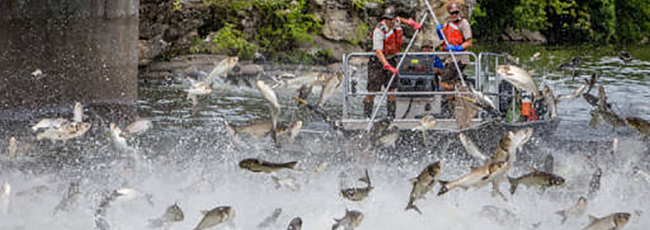Contacts:
Helen Domske, New York Sea Grant, E: SGBuffal@cornell.edu, P: 716-645-3610
Kara Lynn Dunn, NYSG Great Lakes Freelance Publicist, E: karalynn@gisco.net, P: 315-465-7578

Work to keep Asian carp, like the silver carp, out of the Great Lakes continues by multiple federal and state agencies. That includes cutting off the potential connectivity with Lake Erie watersheds. Credit: U.S. Fish and Wildlife Service.
Buffalo, NY, October 30, 2017 - The Great Lakes Sea Grant Network has released a comprehensive report on Asian carp in the Great Lakes region. New York Sea Grant (NYSG) coastal education and fisheries specialists contributed to development of the “Education and Outreach on Asian Carp” report (pdf) that includes information on carp life history, movement and behavior, monitoring, control, ecosystem impacts and gaps in current knowledge that need to be addressed further.
“Asian carp pose a real threat to the ecosystem health of the Great Lakes and this report provides valuable information including biology, management, and educational resources to help concerned citizens learn more about these unwanted fish,” said New York Sea Grant Coastal Education Specialist Helen Domske, who contributed to the development of the carp report with now-retired New York Sea Grant Fisheries and Ecosystem Health Specialist David B. MacNeill.
Asian carp is the collective name used for four non-native species of carp from Asia currently found in North America. Modeling by the US Fish and Wildlife Service shows the Great Lakes are at risk of invasion from all four species.
A survey of state and federal agency experts summarizes current research on Asian carp and identifies ongoing information needs.
The report lists 77 education and outreach materials from the Great Lakes and Mississippi basins that can be used to educate stakeholders on the invasive fish. That list includes a New York Sea Grant Fact Sheet by Domske and MacNeill on the Asian Carp threat specifically to the Lower Great Lakes and St. Lawrence River (pdf).
Domske, based in Buffalo, N.Y., is one of four experts in New York in a state-by-state list of speakers available to help local interest groups interested in educating members directly about Asian carp.
“This comprehensive report gives us three pieces of valuable information, which support our fight against Asian carps as a threat to the Great Lakes" said Debbie Lee, director of the NOAA Great Lakes Environmental Research Laboratory, Ann Arbor, MI, and that agency's lead member of the Asian Carp Regional Coordinating Committee. "It provides a clear picture of the overall potential impact of an Asian carp invasion of the lakes, it identifies specific gaps in our understanding of that impact, and, lastly, it contains a large inventory of outreach and education materials that scientists, managers, and educators can use to communicate the Asian carp threat to the general public."
The Education and Outreach on Asian Carp report and plan development by Ohio State University was funded by the Great Lakes Restoration Initiative (GLRI) through the Asian Carp Regional Coordinating Committee.
More Info: Asian Carp
The Asian carp known for jumping out of the water and possibly injuring boaters is predominantly silver carp, which was brought to the United States for aquaculture along with bighead carp, grass carp, and black carp. The species most commonly of concern in the Great Lakes are silver carp and bighead carp, which are moving up the Illinois River towards the Chicago Area Waterways System that connects the river with the Great Lakes.
The primary concern over Asian carp in the Great Lakes is their impact on an already stressed food web. Silver carp and bighead carp compete with small forage fish and young sport fish for food and could negatively impact the lakes’ fishing industry. Grass carp eat the vegetation that provides prime wetland habitat and black carp feed on mollusks like native mussels, many of which are endangered. At the same time, Asian carp have few natural predators because they quickly outgrow native predator species, often within just a year.
In parts of the Illinois River, silver carp and bighead carp make up more than 90% of the fish biomass, essentially out-competing all native species for food and habitat.
More Info: Sea Grant
The Great Lakes Sea Grant Network is a collaboration of Sea Grant programs along the Great Lakes, which includes Illinois-Indiana Sea Grant, Lake Champlain Sea Grant, Michigan Sea Grant, Minnesota Sea Grant, New York Sea Grant, Ohio Sea Grant, Pennsylvania Sea Grant and Wisconsin Sea Grant. For more information, visit greatlakesseagrant.com.
New York Sea Grant (NYSG), a cooperative program of Cornell University
and the State University of New York (SUNY), is one of 33 university-based
programs under the National Oceanic and Atmospheric Administration’s
National Sea Grant College Program.
Since 1971, NYSG has represented a statewide network of integrated
research, education and extension services promoting coastal community
economic vitality, environmental sustainability and citizen awareness
and understanding about the State’s marine and Great Lakes resources.
Through NYSG’s efforts, the combined talents of university scientists
and extension specialists help develop and transfer science-based
information to many coastal user groups—businesses and industries,
federal, state and local government decision-makers and agency managers,
educators, the media and the interested public.
The program maintains Great Lakes offices at Cornell University, SUNY
Buffalo, SUNY Oswego and the Wayne County Cooperative Extension office
in Newark. In the State's marine waters, NYSG has offices at Stony Brook
University in Long Island, Brooklyn College and Cornell Cooperative
Extension in NYC and Kingston in the Hudson Valley.
For updates on Sea Grant activities: www.nyseagrant.org has RSS, Facebook, Twitter, and YouTube links. NYSG produces a monthly e-newsletter, "NOAA Sea Grant's Social Media Review," via its blog, www.nyseagrant.org/blog. Our program also offers a free e-list sign up via www.nyseagrant.org/coastlines for its flagship publication, NY Coastlines/Currents, which is published quarterly.